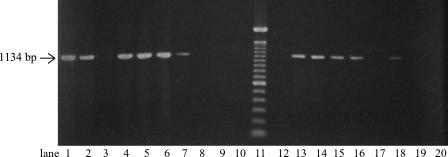FIG. 1.
Gel containing selected samples from the Angiostrongylus spp. PCR. The arrow indicates the size (1,134 bp) of the expected PCR products. Lane 11 contained a 100-bp ladder DNA size marker. Lanes 1 though 3 show results obtained with fresh P. martensi tissue (lane 1, larvae isolated from an infected individual; lane 2, tissue from the same individual; lane 3, tissue from noninfected P. martensi). Lanes 4 through 10 show the effect on storage of Angiostrongylus-infected tissue from P. martensi (lane 4, 1 month of storage at −18°C; lane 5, 1 month of storage at −18°C followed by storage for 24 h at 5°C; lane 6, 1 month of storage at −18°C followed by storage for 24 h at room temperature; lane 7, 2 weeks of storage in 70% ethanol; lane 8, 4 weeks of storage in 70% ethanol; lane 9, 2 weeks of storage in 95% ethanol; lane 10, 4 weeks of storage in 95% ethanol). Lanes 12 through 16 show results for mucus secretions spiked with known numbers of A. cantonensis larvae (lane 12, no larvae; lane 13, one larva; lane 14, two larvae; lane 15, 10 larvae; lane 16, 37 larvae). Lane 17 and 18 show results for mucus excreted from two A. cantonensis-infected P. martensi individuals. Lanes 19 and 20 show results for non-Angiostrongylus nematodes (lane 19, free-living nematode belonging to an unknown species; lane 20, Dipetalonema sp.).

